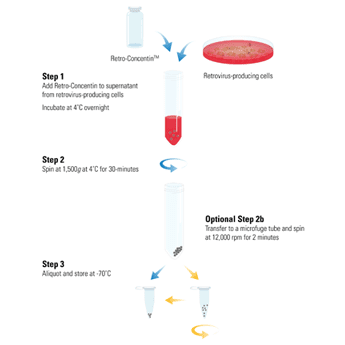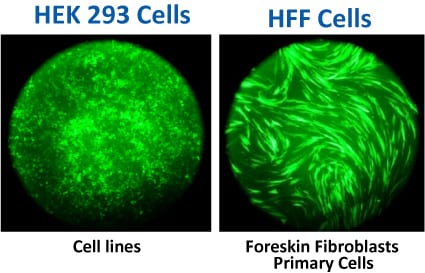Retro-Concentin™ Retroviral Concentration Reagent
- Fast protocol
- Cost-effective
- Up to 100-fold concentration of retrovirus particles
Products
| Catalog Number | Description | Size | Price | Quantity | Add to Cart | |||
|---|---|---|---|---|---|---|---|---|
| RV100A-1 | Retro-Concentin | 100 mL | $508 |
|
||||
Overview
Overview
Increase the infectivity of any retrovirus by concentrating with Retro-Concentin
Quantitatively precipitate any retrovirus with Retro-Concentin™. Instead of using lengthy spins in an ultracentrifuge, Retro-Concentin enables concentration of retroviruses directly from culture medium with a simple one (or an optional two) low-speed centrifugation steps.
In addition, Retro-Concentin stabilizes the retroviruses for frozen storage, providing an additional advantage over other concentration methods.
Each preparation can handle up to 200 mL of retroviral supernatant, which is compatible with most centrifuges, and the resulting pellet can be dissolved in the volume of buffer that meets your experimental requirements.
With Retro-Concentin, you get simple and effective retrovirus concentration:
- Fast protocol
- Cost-effective
- Up to 100-fold concentration of retrovirus particles
References
How It Works
How It Works
Retro-Concentin supports a fast, simple, and ultracentrifugation-free workflow
Simply add Retro-Concentin to retrovirus supernatant, incubate at 4°C overnight, and then spin at 1,500g for 30-minutes at 4°C. An optional spin in a microfuge tube at 12,000 rpm for 2 minutes can further concentrate the retrovirus particles.
Supporting Data
Supporting Data
Retrovirus particles concentrated with Retro-Concentin are non-toxic and effective at transduction
Figure 1. Retrovirus particles concentrated with Retro-Concentin are non-toxic and effective at transduction. Transduced cells show normal morphology and with no obvious cytotoxicity, and were successfully used for generating induced pluripotent stem cells.
FAQs
Documentation
Citations
Related Products
Products
| Catalog Number | Description | Size | Price | Quantity | Add to Cart | |||
|---|---|---|---|---|---|---|---|---|
| RV100A-1 | Retro-Concentin | 100 mL | $508 |
|
||||
Overview
Overview
Increase the infectivity of any retrovirus by concentrating with Retro-Concentin
Quantitatively precipitate any retrovirus with Retro-Concentin™. Instead of using lengthy spins in an ultracentrifuge, Retro-Concentin enables concentration of retroviruses directly from culture medium with a simple one (or an optional two) low-speed centrifugation steps.
In addition, Retro-Concentin stabilizes the retroviruses for frozen storage, providing an additional advantage over other concentration methods.
Each preparation can handle up to 200 mL of retroviral supernatant, which is compatible with most centrifuges, and the resulting pellet can be dissolved in the volume of buffer that meets your experimental requirements.
With Retro-Concentin, you get simple and effective retrovirus concentration:
- Fast protocol
- Cost-effective
- Up to 100-fold concentration of retrovirus particles
References
How It Works
How It Works
Retro-Concentin supports a fast, simple, and ultracentrifugation-free workflow
Simply add Retro-Concentin to retrovirus supernatant, incubate at 4°C overnight, and then spin at 1,500g for 30-minutes at 4°C. An optional spin in a microfuge tube at 12,000 rpm for 2 minutes can further concentrate the retrovirus particles.
Supporting Data
Supporting Data
Retrovirus particles concentrated with Retro-Concentin are non-toxic and effective at transduction
Figure 1. Retrovirus particles concentrated with Retro-Concentin are non-toxic and effective at transduction. Transduced cells show normal morphology and with no obvious cytotoxicity, and were successfully used for generating induced pluripotent stem cells.



